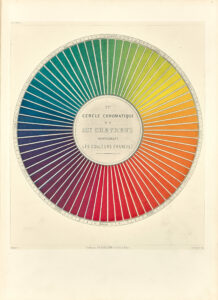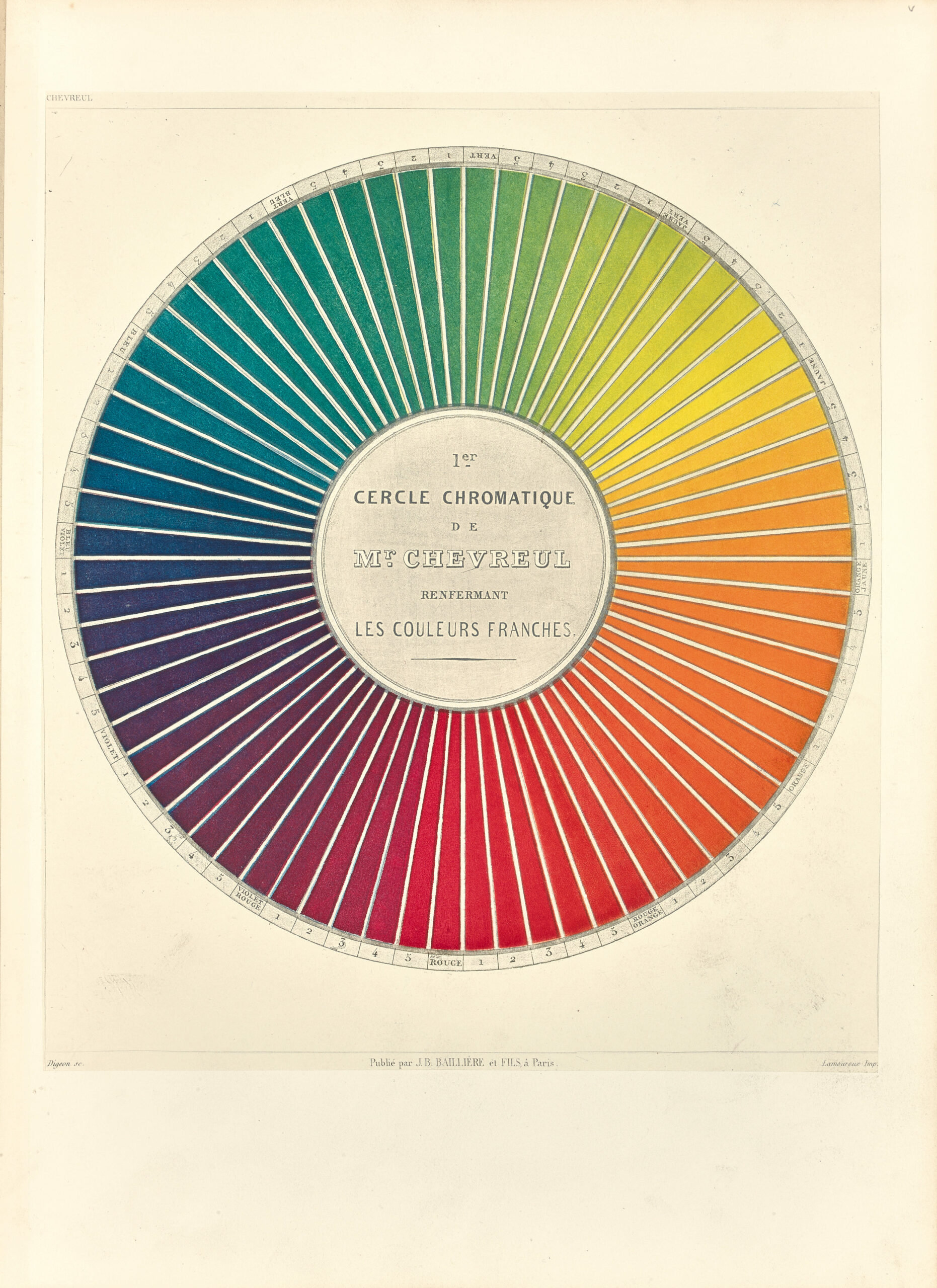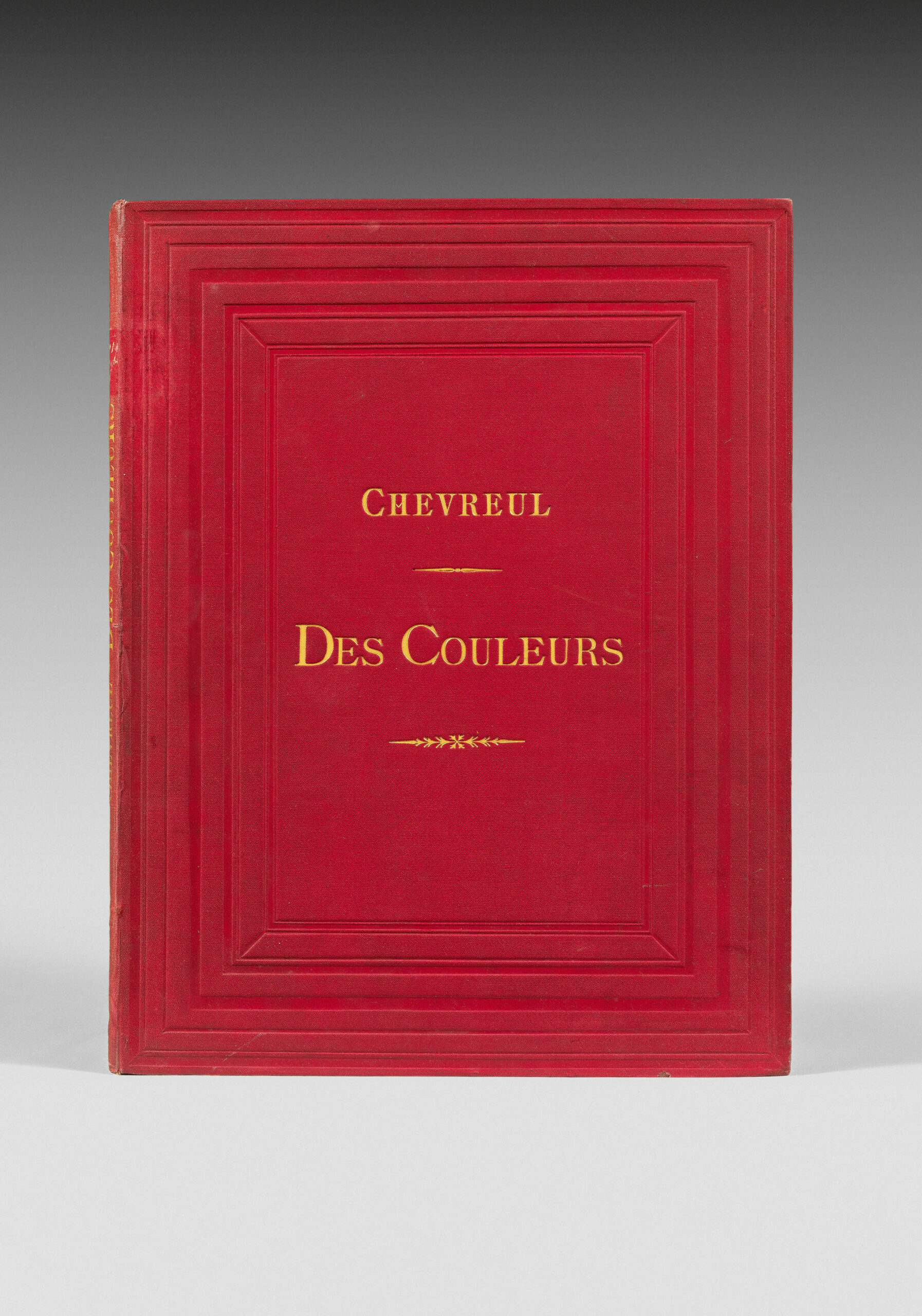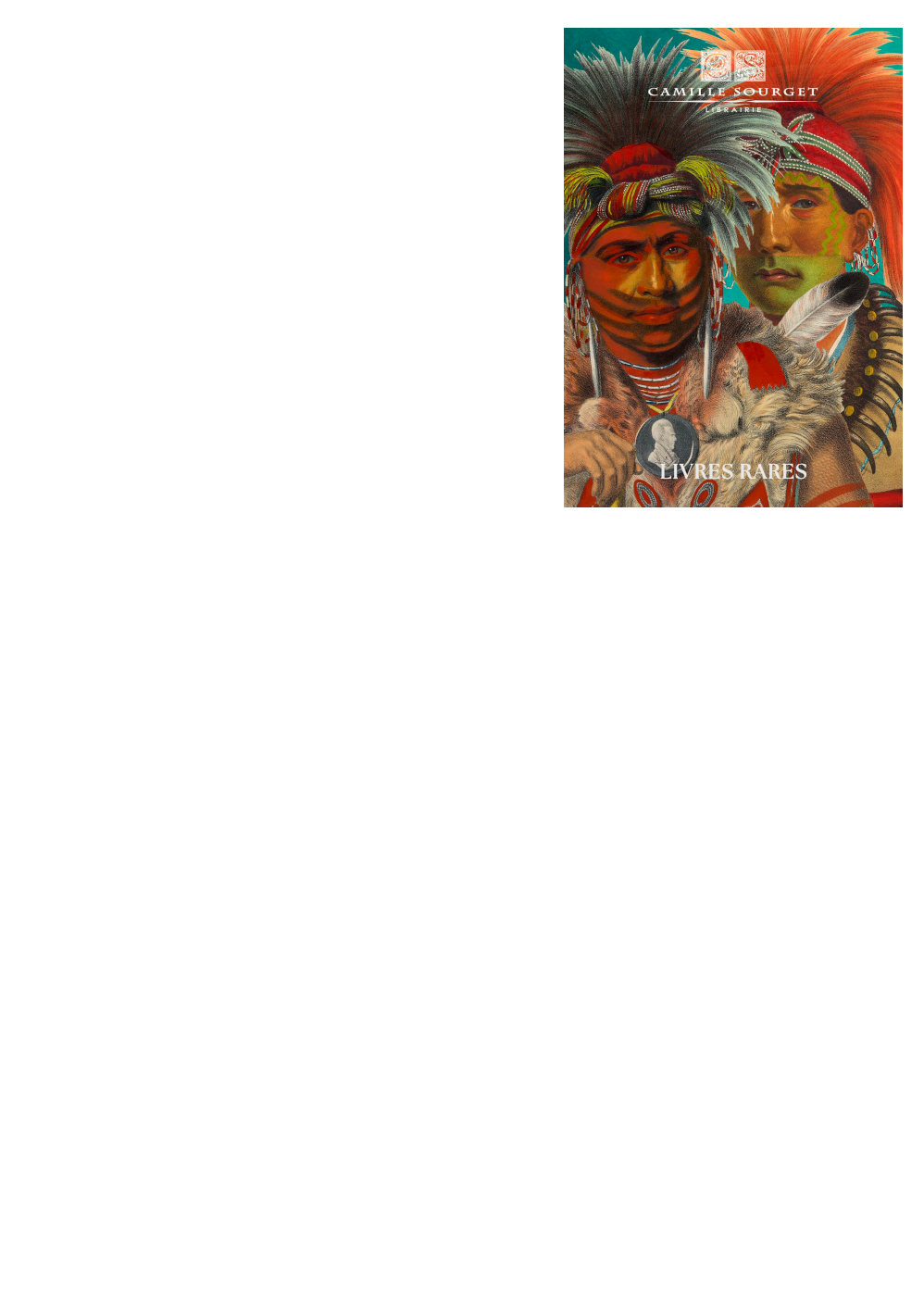Paris, J.B. Baillière et Fils, 1864.
Folio of 26 pp., (1) l. of table, 27 color plates mounted on guards, including 1 folding and 26 full-page.
Publisher’s full red cloth, gilt author and title on upper cover and spine, numerous bind-stamped framing fillets, browned endpapers with publisher’s catalog. Publisher’s binding.
363 x 280 mm.
Precious first edition of the rarest of Eugene Chevreul’s publications on color.
“By publishing this work, we wished to bring within everyone’s reach the essentially practical results that Mr. Chevreul has obtained for the definition and naming of colors, and to popularize notions that are of undeniable utility for art, industry and industrial art.” (Editors’ note). Chevreul’s standards for defining and naming colors are still in use today.
In it, Chevreul develops the practical results he had obtained for defining and naming colors.
For the first time, it explains how to obtain successive gradations of several colors in 13 chromatic ranges: gray, violet-red, orange-red, orange-yellow, yellow, yellow-green, green, green-blue, blue, blue-violet, violet and red.
Chevreul also includes in this treatise the 14 color plates from the atlas that accompanied Exposé d’un moyen de définir et de nommer les couleurs (1861).
Chevreul was Director of Dyeing at the Manufactures Royales des Gobelins and professor of chemistry and later director of the Museum d’Histoire Naturelle, and he based his color treatise on empirical observation, intending it for the use of painters, textile designers, decorators, gardeners, etc., rather than scientists.
Chevreul’s “colour studies made him one of the most influential scientists of the nineteenth century” (DSB).
Michel-Eugène Chevreul (1786-1889) is known to chemists for his research into fatty substances (1810-1823) and immediate organic analysis (1824); painters and all those whose trade involves colors (dyers, printers, publicists, photographers, gardeners, architects, master glassmakers…) recognize him as a color theorist.
Born in Angers on August 31, 1786, he studied in Paris with Vauquelin, who introduced him to the Muséum d’Histoire naturelle. He succeeded Vauquelin as Professor of Chemistry Applied to Organic Bodies in 1829, and remained at the Muséum until his death on April 9, 1889. At the time of Napoleon’s blockade, his early work focused on the research and extraction of indigenous dyes for military cloth.
On September 9, 1824, Louis XVIII appointed him Director of Dyes at the Manufactures royales de tapisseries et de tapis des Gobelins, de Beauvais and de la Savonnerie, a post he held until 1883. He taught a course in chemistry applied to dyeing, which brought him into contact with many provincial and even foreign dyers. From then on, the color research he carried out in his Gobelins laboratory took precedence over his chemistry work.
Ampère encouraged him to formulate his observations in the form of a law. And so, in 1839, he published a voluminous work, in which he considered virtually every application of color: “De la loi du contraste simultané des couleurs et de l’assortiment des objets colorés considéré d’après cette loi dans ses rapports avec la peinture, les tapisseries des Gobelins, les tapisseries de Beauvais, pour meubles, les tapis, la mosaïque, les vitraux colorés, l’impression des étoffes, l’imprimerie, l’enluminure, la décoration des édifices, l’habillement et l’horticulture“, in which he prescribes, “pour produire un effet agréable, le rapprochement de couleurs complémentaires“.
The work was republished at public expense in 1889 to mark Chevreul’s centenary. Far from being outdated, it ranks among the twelve most important books on color. According to Chevreul, this work “is just as experimental and positive as the previous two” (on fatty substances and organic analysis).
Chevreul also established the law of color mixing. We also owe him the most complete catalog of ancient hues in the form of chromatic circles, which constitute a system for measuring colors. Today, this system is computerized under the name NIMES by Manufacture des Gobelins. As early as 1840, contrast was being used in the printing workshops of common paintings. Chevreul’s laws provided colorists with the means to eliminate the undesirable effects of contrasts, by correcting the yellow effect, for example, imposed on green when juxtaposed with blue, through the choice of an opposite shade. Chevreul’s laws gave these “accidents” a scientific universality. In the interview he gave Nadar on his 100th birthday, announcing symbolism and abstraction, “to faithfully copy the colored model, it is necessary,” he said, “to copy it differently than we see it“.
As a juror at numerous industrial exhibitions, member of ministerial commissions and chairman of the Comité consultatif des Arts et Manufactures, he was also in contact with many artists and painters concerned with color. In 1855, he published Cercles chromatiques by M.-E. Chevreul, reproduced using chromochalcography. In 1864, a second work completed his 1839 law: “Des couleurs et de leurs applications aux arts industriels à l’aide des cercles chromatiques“, followed in 1879 by “Compléments d’études sur la vision des couleurs“, devoted to rotational contrast.
His work had a considerable influence on the Impressionists, and even more so on Seurat and the Pointillists (Neo-Impressionists).
The work is illustrated with 27 engraved plates by René Digeon and printed in color by Lamoureux.
A very fine copy, free of foxing. Extremely rare, especially in this condition!



